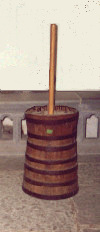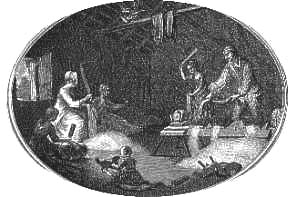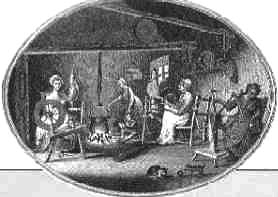Women's work
Women's work made a major contribution to the Irish economy in the early modern period. Irish society was pre-industrial and the economy was based mainly on households, most of which were self-sufficient. All available family members contributed at home to the production of food and other necessities as well as to the family income.
There were traditional women's jobs such as cooking, sewing, washing, spinning, butter and cheese making, child care, nursing and other caring work. Women and children also assisted on the farm with jobs requiring less physical strength such as milking cows, weeding, binding sheaves and feeding poultry and pigs.
In the absence of factories and offices, domestic service in the houses and castles of the rich was an important source of paid employment and the custom of hiring one or two female servants spread to many smaller farm households in the eighteenth century. Women and children might find part time seasonal work on big estates, weeding and clearing ground for sowing in spring and gathering at harvest time. Child-minding, sewing and laundry work might be available also.
Nursing mothers were hired for short periods as wet nurses while others were paid occasionally to work as nurses or maids during the illness of a member of a household or to help out with spring cleaning or some particular task. Estate accounts also indicate that local women provided other services such as washing clothes, sewing and supplying food produce for the staff and family in the house.
Mary O'Dowd, 'Women and paid work in rural Ireland, c.1500-1800' in Bernadette Whelan, Women and paid work in Ireland 1500-1930, Dublin, 2000, p.19. |
|
Poor women and children went begging to places where they hoped they would not be recognised during 'lean times', which usually occurred in the early summer when the previous season's food had run out and the new season's crops were too immature to harvest.
Butter was Ireland's largest agricultural product by the end of the eighteenth century. It was produced mainly by women in Cork, Limerick, South Tipperary and North Kerry as well as in other areas, brought to market and exported to Britain and the colonies from ports in the south, especially from Cork.
|

Dash churn
The handle was pumped up and down
repeatedly to turn cream into butter. |
Domestic textile industries
Irish women, spinning wool and linen yarn for centuries with the distaff and spindle, helped to keep the country self sufficient in cloth except for finer, luxury cloths. They also made a major contribution to Ireland's lively export trade in yarns.
Wool, produced mainly in the south, was spun by women in the home. It would be woven later into coarse materials such as frieze and perhaps made up into mantles. There was a market at home for new and secondhand textiles, while for centuries, Irish yarn and woollen materials were major export products.
By the end of the seventeenth century exports of wool and woollen yarns accounted for more than half the value of Irish exports to England and linen yarn for one-eighth. Because England could not produce sufficient yarns to service its own textile industries it had to pay good prices to attract yarns from Ireland.
W.H. Crawford, 'Women in the domestic linen industry' in Margaret MacCurtain & Mary O'Dowd, Women in early modern Ireland, Dublin, 1991, p.255. |
However, the English government, under pressure from English wool merchants, restricted the trade in Irish woollen products from 1699 and in later years, cottage textile industries were unable to compete with industrialised spinning and weaving.
The linen industry developed steadily during the seventeenth century and Irish spinners were encouraged to convert from the traditional distaff and spindle to the spinning wheel. Ulster landlords offered long leases and low rents to attract people from England and Scotland and a thriving linen industry featured alongside farming in the northern half of the country. Huguenots migrating here after the Revocation of Nantes (1685) brought new skills and expertise.
The linen industry was Ireland's most important manufacturing industry during the eighteenth century. It was mainly concentrated in the north and north west, especially in Ulster which grew to be the most prosperous area in the country at the time. Success was due to the domestic system which was based on the household unit. Women, men and children worked at home, outdoors and indoors, producing linen cloth from their own home-grown flax. William Hincks made twelve engravings in 1783 illustrating the various processes involved from the growing of flax to the weaving of linen cloth.

William Hincks engraving
Shows women scutching and hackling flax
Reproduced by kind permission of the Museums & Galleries of Northern Ireland
|

William Hincks engraving
Shows women spinning, clicking, measuring and washing yarn
Reproduced by kind permission of the Museums & Galleries of Northern Ireland
|
- Ploughing and sowing came first.
- Then men and women together pulled the stalks and rippled them to extract the seeds.
- The flax stalks were immersed in water for three weeks to be retted - a job often reserved for married men because of the unpleasant smell!
- Women and men co-operated in drying the stalks and in beetling and scutching to release the fibres from the stalks.
- Next the fibres were drawn through hackling combs to refine them and they were now ready for the women to arrange on the distaff and make them into yarn on their spinning wheels.
- The yarn was wound onto click reels by women and children, measured, washed and dried.
- Then it was usually handed over to the men who did the weaving and brought the 'brown linen' to market to be sold to large enterprises who carried out the bleaching and finishing.
The earnings of women spinning in their homes were similar to those of agricultural labourers but more regular, being independent of the seasons and the weather.
In Westport, Arthur Young noted that: 'In their domestic economy, they reckon that the men feed the family with their labour in the field and the women pay the rent by spinning.'
Mary O'Dowd, 'Women and paid work in rural Ireland, c.1500-1800' in Bernadette Whelan, Women and paid work in Ireland 1500-1930, Dublin, 2000, p.20. |
Young women who took control of their own earnings did not always meet with approval:
A number of eighteenth century writers record the presence of female servants at markets spending their money on fashionable items and clothing. Mary Leadbeater's moral tales warned of the poor quality of bought goods and urged servants to save their money and make their own clothes. Her depiction of Nancy, the maid who got into debt with the local shopkeeper for buying clothes, was probably, however, more typical of most maids than her description of Rose who saved money to buy wool and cloth to make some clothes for herself.
Mary O'Dowd, 'Women and paid work in rural Ireland, c.1500-1800' in Bernadette Whelan, Women and paid work in Ireland 1500-1930, Dublin, 2000, p.20. |
Demand for Irish linen rose rapidly at home and in England and the colonies during the eighteenth century and more than two-thirds of all linen woven was exported. Secondary processes developed, such as embroidery, printing, fine cambric and thread-making.
However the domestic linen industry declined towards the end of the eighteenth century when cheap factory-produced cotton began to displace it. Many Ulster women drifted to work in cotton mills in Belfast and the social profile of the province changed radically. By 1811, about 50,000 people, mainly women were employed in cotton factories in or near Belfast.
Questions
- Write a brief paragraph on the topic of butter in the Irish economy.
- What might be the advantages and disadvantages of a household economy.
- Write a brief paragraph on the topic of linen in the Irish economy.
- State reasons why Ulster became the most prosperous province in Ireland in the eighteenth century.
- To work at home in the household economy or to work in a Belfast cotton mill in the eighteenth century? State your preference and give reasons.
Activities
- Compose a diary or journal entry for a young girl in an Ulster home in the eighteenth century.
- Research the appearance and purpose of the following: distaff, spindle, spinning wheel, loom.
- Research the engravings of William Hincks.
- State the purpose of each of the following processes in the linen industry: rippling; retting; beetling; scutching; hackling; spinning; weaving; bleaching.
- Visit the Lisburn Linen Museum and do a project on the domestic linen industry in Ulster.
- Research any aspect of the textile industry during the Industrial Revolution.
- Research and do a project or display on Needlework.


